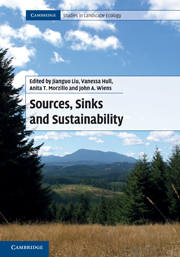Book contents
- Frontmatter
- Contents
- Contributors
- Preface
- Acknowledgments
- Part I Introduction
- Part II Advances in source–sink theory
- Part III Progress in source–sink methodology
- Part IV Improvement of source–sink management
- 16 Contribution of source–sink theory to protected area science
- 17 Evidence of source–sink dynamics in marine and estuarine species
- 18 Population networks with sources and sinks along productivity gradients in the Fiordland Marine Area, New Zealand: a case study on the sea urchin Evechinus chloroticus
- 19 Source–sinks, metapopulations, and forest reserves: conserving northern flying squirrels in the temperate rainforests of Southeast Alaska
- 20 Does forest fragmentation and loss generate sources, sinks, and ecological traps in migratory songbirds?
- 21 Source–sink population dynamics and sustainable leaf harvesting of the understory palm Chamaedorea radicalis
- 22 Assessing positive and negative ecological effects of corridors
- Part V Synthesis
- Index
- References
20 - Does forest fragmentation and loss generate sources, sinks, and ecological traps in migratory songbirds?
Published online by Cambridge University Press: 05 July 2011
- Frontmatter
- Contents
- Contributors
- Preface
- Acknowledgments
- Part I Introduction
- Part II Advances in source–sink theory
- Part III Progress in source–sink methodology
- Part IV Improvement of source–sink management
- 16 Contribution of source–sink theory to protected area science
- 17 Evidence of source–sink dynamics in marine and estuarine species
- 18 Population networks with sources and sinks along productivity gradients in the Fiordland Marine Area, New Zealand: a case study on the sea urchin Evechinus chloroticus
- 19 Source–sinks, metapopulations, and forest reserves: conserving northern flying squirrels in the temperate rainforests of Southeast Alaska
- 20 Does forest fragmentation and loss generate sources, sinks, and ecological traps in migratory songbirds?
- 21 Source–sink population dynamics and sustainable leaf harvesting of the understory palm Chamaedorea radicalis
- 22 Assessing positive and negative ecological effects of corridors
- Part V Synthesis
- Index
- References
Summary
Forest fragmentation and habitat loss on the breeding grounds of migratory songbirds have long been hypothesized to create source–sink dynamics. Forest fragments have increased the populations of many nest predators that are subsidized by food in the surrounding landscape and are themselves released from top predators. Migratory songbirds are also susceptible to brood parasitism by the brown-headed cowbird (Molothrus ater). As a result of reduced nesting success, reproductive output may be driven below the source–sink threshold. Source–sink dynamics occur within forest tracts, among patches in a landscape, and have been hypothesized to occur over entire regions in which sink populations within small tracts in mostly agricultural regions are rescued by distant source populations in mostly forested regions.
In the absence of ongoing habitat loss, habitat fragmentation will only generate continuing population declines if birds lack behavioral mechanisms that enable them to concentrate in the source habitat and avoid population sinks. If sink habitat is attractive, then it can become an ecological trap. There is growing evidence that many birds use decision rules based on nesting success that might enable them to avoid ecological traps created by high rates of nest predation. Most forest birds, however, do not have decision rules to avoid areas with heavy cowbird parasitism.
There are, however, a number of limitations with the fragmentation–source–sink paradigm. First, there is a critical need for improved data on the survival of adult and young birds. Second, we know very little about the spatial scale of dispersal in most species. Third, fragmentation-associated reductions in nesting success appear to be much weaker in some regions, especially in western North America. And fourth, it is far from clear that large habitat patches always act as source populations. Nevertheless, a conservation strategy that maintains or restores large forest tracts in mostly forested regions seems likely to maximize the ratio of source to sink habitat and to lead to sustainable populations.
- Type
- Chapter
- Information
- Sources, Sinks and Sustainability , pp. 423 - 449Publisher: Cambridge University PressPrint publication year: 2011
References
- 8
- Cited by

